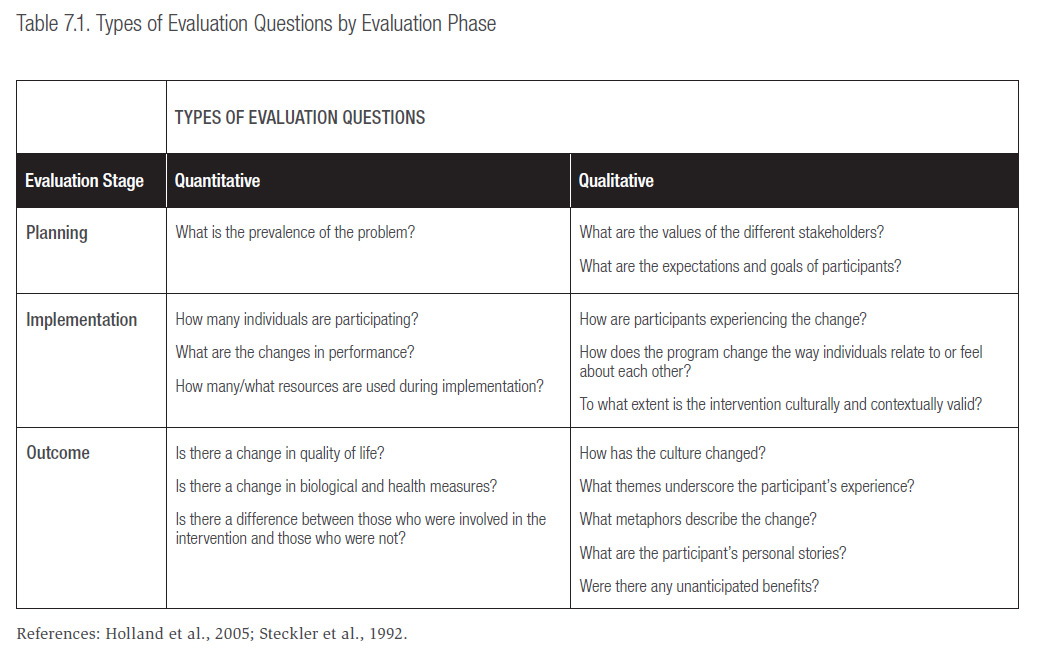What to know
This section describes the purposes and characteristics of the Participatory Evaluation and Empowerment Evaluation used in framing an evaluation of community engagement.

Section Overview
The two approaches to evaluation are useful when framing an evaluation of community engagement programs while engaging stakeholders. Below are both approaches and their characteristics:
Participatory evaluation can help improve program performance by
- Involving key stakeholders in evaluation design and decision making,
- Acknowledging and addressing asymmetrical levels of power and voice among stakeholders,
- Using multiple and varied methods,
- Having an action component so that evaluation findings are useful to the program’s end users, and
- Explicitly aiming to build the evaluation capacity of stakeholders
Characteristics of participatory evaluation:
- Focus on participant ownership and stakeholder needs
- Consensus-building and problem-solving among participants
- Input sought from all participants
- Emphasis on lessons learned for program improvement
- Flexible evaluation design based on empirical data
Approach that helps ensure program success by providing stakeholders with tools and skills to evaluate their program and ensuring that the evaluation is part of the planning and management of the program. The major goal of empowerment evaluation is to transfer evaluation activities from an external evaluator to the stakeholders Empowerment evaluation has four steps:
- Taking stock of the program and determining where it stands, including its strengths and weaknesses
- Establishing goals for the future with an explicit emphasis on program improvement
- Developing strategies to help participants determine their own strengths that they can use to accomplish program goals and activities
- Helping program participants decide on and gather the evidence needed to document progress toward achieving their goals
Characteristics of empowerment evaluation:
- Values improvement in people, programs, and organizations
- Community ownership of evaluation design and implementation
- Democratic participation and clear evaluation plans/methods
- Commitment to social justice and fair resource allocation
- Use of community knowledge, evidence-based strategies, and organizational learning
- Building capacity of program staff and participants for self-evaluation
- Accountability to funders' expectations
Tips From the Literature
Disadvantages of Participatory and Empowerment Evaluation
- The evaluation could be viewed as less objective because of stakeholder involvement.
- Potential challenges in addressing technical aspects.
- Time and resource requirements when involving multiple stakeholders.
- Possibility of domination or misuse by certain stakeholders to further their own interests.

References
Burke B. Evaluating for a change: reflections on participatory methodology. New Directions for Evaluation 1998;(80):43-56.
Fetterman DM. Steps of empowerment evaluation: from California to Cape Town. Evaluation and Program Planning 1994;17(3):305-313.
Fetterman DM, Kaftarian SJ, Wandersman A. Empowerment evaluation: knowledge and tools for self-assessment and accountability. Thousand Oaks. (CA): Sage; 1996.
Garbarino S, Holland J. Quantitative and qualitative methods in impact evaluation and measuring results. Social Development Direct; 2009. Retrieved from http://www.gsdrc.org/docs/open/EIRS4.pdf
Patton MQ. Utilization focused evaluation (4th ed.). Saint Paul (MN): Sage; 2008
Wandersman A, Snell-Johns J, Lentz B, Fetterman D, Keener D, Livet M, et al. The principles of empowerment evaluation. Empowerment Evaluation Principles in Practice 2005;27-41.

